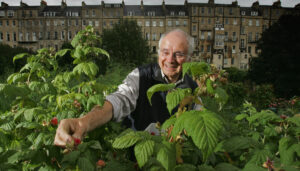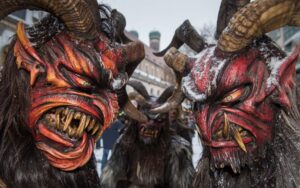When I was a boy, my family went for winter walks on the South Downs. The path up was always an adventure, a runnel of wet leaves and chalk slurry that cut between the trees. Crows made their flat, disapproving calls, but it was otherwise silent once you had climbed away from the road. Up top we trudged along the South Downs Way. Our sign to turn back was a series of lumpy grass mounds.
I always called the largest mound a hill fort, though I have no idea if it qualified for the title. This was no Maiden Castle. The ring’s centre can’t have held more than a family and a few pigs. Yet here it still was, thousands of years on. That modest earthwork was my first experience of Deep England — or Deep Britain, since the fort was constructed centuries before England was born.
Deep England is not a place. It is a shock. A sudden awareness of time freed from measurement and scale. Such a shock can be triggered by a hill fort, a shaped stone, a worn staircase. But you don’t need to tramp the Sussex countryside to find Deep England. It can be felt in the paintings of David Inshaw and Simon Palmer, the poetry of Geoffrey Hill, the work of Alan Garner. And at this time of year, it can easily be found in John Masefield’s 1935 Christmas tale The Box of Delights, one of those children’s books best enjoyed by adults.
A brush with Deep England might produce feelings of recognition and homecoming; equally, time’s long drop can inspire eeriness and threat. The best art devoted to England’s deep past is always a shuffling of the familiar and the strange. This makes Christmas the perfect time to reflect on the passage of centuries. There is a strained cosiness to modern Christmas, but beneath the lights and mulled wine lurks the black pause of the year’s end. It is a time for barred doors and ghost stories. John Masefield understood these things.
Masefield was Poet Laureate from 1930 until his death in 1967. In 1953, Muriel Spark declared that “John Masefield is known to all of us… I do not think there is any need of a book to make him wider known.” My father can still recite Masefield’s poem “Cargoes”, drummed into him as a schoolboy in Sixties Belfast. And yet, a few short decades later, Masefield has joined the ranks of the unread. This is not an unusual fate for a Poet Laureate, but it is sad in Masefield’s case. He wrote good verse, and although some of his work has withered on the page, much still sings.
If anyone under the age of 60 knows of Masefield today it is because of The Box of Delights. The story is simple enough. Kay Harker is going home for the Christmas holidays. He meets an old eccentric on the station platform, a Punch and Judy showman with a fondness for gnomic utterances: Cole Hawlings. But he is in trouble. He is being hunted across England by dark forces, and although he has powers of his own, they are waning. He asks for Kay’s help: “Now that the Wolves are Running, perhaps you would do something to stop their Bite?” Kay agrees to safeguard the Box of Delights, a magical object that serves as a doorway to the distant past.
Masefield was a great proponent of the old-fashioned yarn. In his autobiography So Long to Learn, he emphasised the importance of straightforward storytelling. The rarefied devices of celebrated writers did not interest him. He wanted the spare, salty narratives of earlier epochs: “The sagas with their simple power made the story-telling of most of our masters almost absurd. What was Flaubert, with his labour and richness of language; what was Pater, with his learning and instinct for felicity, to the tellers of the Laxdale or Njala sagas?” For Masefield, “literature” was an obstruction, an elaborate rood screen that hid a story from its audience.
The Box of Delights is a great story simply told. But it is not just the story of Kay Harker. It is the story of Britain. “A nation’s past is the poet’s pasture,” said Masefield, and Kay’s adventures bear this out. The winter landscape surrounding his village is a map of the past: the ruined Abbey, the Roman road, the hill fort known as Arthur’s Camp, even the trees that advance and retreat as Kay moves through time. He marches with legionaries, fights alongside ancient Britons, and gallops through the forest with Herne the Hunter. Always the Wolves are there, a sinister army that harries mankind. Cole Hawlings is himself a figure from the deep past, though fading now. Once the forces of good and evil were evenly matched, but his enemies have learnt new tricks. They employ the latest technology and prosper in plain sight amid respectable society, while Hawlings and his allies must live on the run.
The tale’s Christmas setting serves as more than a cosy backdrop. The Box of Delights is a book about time, and the Winter Solstice is the appropriate moment to consider the passage of countless years. More specifically, the book is about deep time unfolding in one particular place. And so it is appropriate that in the final chapter, Kay attends the Christmas service at Tatchester cathedral, the thousandth such service to have been held there — the rhythms of worship are the only clock that can measure deep time. While Masefield’s reach extended back far beyond the arrival of Christianity in Britain, the novel is unambiguous in its religious message. Greed and aggression are punished, and the weak triumph at the close. Even Cole Hawlings, who has been knocking about “since Pagan times”, adheres to the new faith:
“In one place, the river ran through a wide cavern, the wall of which had been painted with a procession of men leading bulls and horses. ‘That was our old religion, Master Harker,’ Cole said, nodding towards it. ‘It was nothing like so good as the new, of course…’”
The Box of Delights remains in print. It was brilliantly adapted for the BBC in 1984, with a grizzled and twinkling Patrick Troughton starring as Hawlings, and a play based on the book is currently on at the Royal Shakespeare Company. There is no doubt that the novel has an enduring appeal.
While much of the dialogue is couched in Blytonisms (“splendiferous!”), and although its commitment to place and history could not be less fashionable, the story still delivers. It is perhaps more powerful now than when it was first published. Masefield’s world has joined the far-off epochs visited by Kay, just as ours soon will. Layers and layers of time and history will deepen Deep England further. As Cole Hawlings says, “Hearts, diamonds, spades, clubs it goes. And then all the way back again.”
Disclaimer
Some of the posts we share are controversial and we do not necessarily agree with them in the whole extend. Sometimes we agree with the content or part of it but we do not agree with the narration or language. Nevertheless we find them somehow interesting, valuable and/or informative or we share them, because we strongly believe in freedom of speech, free press and journalism. We strongly encourage you to have a critical approach to all the content, do your own research and analysis to build your own opinion.
We would be glad to have your feedback.
Source: UnHerd Read the original article here: https://unherd.com/



